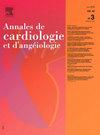Predictive Value of Tpeak-to-Tend/QT for Early Ventricular Arrhythmias and Arrhythmogenic Death in Patients with Anterior ST Elevation Myocardial Infarction
IF 0.3
Q4 Medicine
引用次数: 0
Abstract
Background
Patients with anterior ST elevation myocardial infarction (STEMI) are vulnerable to life-threatening ventricular arrhythmia and arrhythmic death. This study aimed to investigate the predictive value of Tpeak-to-Tend (TpTe) and TpTe/QT ratio in patients with anterior STEMI on admission for the occurrence of in-hospital life-threatening ventricular arrhythmias and arrhythmic death.
Methods
This observational cross-sectional research was performed on patients with anterior STEMI who showed up within 12 hours of the beginning of symptoms and received the initial percutaneous coronary intervention (pPCI). The primary study endpoints included the assessment of sustained ventricular arrhythmias and all-cause/arrhythmic deaths throughout the hospitalization. Data collection involved clinical history, vital signs monitoring, ECG measurements, LVEF evaluation, and performance of pPCI procedures.
Results
The studied patients had a mean age of 53 ± 11 years. Patients with arrhythmic events displayed a significant rise in QT dispersion, TpTe, TpTe/QT, and arrhythmic death rates (P < 0.05). A multivariate logistic regression examination revealed that HR (with an OR of 1.037 and a 95% CI of 1.004 to 1.071, P = 0.027), TpTe (with an OR of 1.025 and a 95% CI of 1.004 to 1.047, P = 0.022), and TpTe/QT (with an OR of 5.464 and a 95% CI of 2.027 to 14.726, P = 0.001) were found to be significant predictors of arrhythmic events or mortality.
Conclusion
In patients with anterior STEMI, TpTe and TpTe/QT ratio are significant predictors of in-hospital VA and arrhythmic death. Higher TpTe and TpTe/QT values are linked to a higher risk of these occurrences.
Tpeak-to-Tend/QT对前ST段抬高型心肌梗死患者早期室性心律失常和心律失常性死亡的预测价值。
背景:前ST段抬高型心肌梗死(STEMI)患者容易发生危及生命的室性心律失常和心律失常性死亡。本研究旨在探讨前 STEMI 患者入院时 Tpeak-to-Tend(TpTe)和 TpTe/QT 比值对发生院内危及生命的室性心律失常和心律失常死亡的预测价值:这项观察性横断面研究的对象是在症状出现后 12 小时内就诊并接受首次经皮冠状动脉介入治疗(pPCI)的前 STEMI 患者。主要研究终点包括评估整个住院期间的持续室性心律失常和全因/心律失常死亡。数据收集包括临床病史、生命体征监测、心电图测量、LVEF 评估以及 pPCI 手术的实施:研究对象的平均年龄为 53 ± 11 岁。心律失常患者的 QT 离散度、TpTe、TpTe/QT 和心律失常死亡率显著上升(P < 0.05)。多变量逻辑回归检查显示,HR(OR 为 1.037,95% CI 为 1.004 至 1.071,P = 0.027)、TpTe(OR 为 1.025,95% CI 为 1.004 至 1.047,P = 0.022)和 TpTe/QT(OR 为 5.464,95% CI 为 2.027 至 14.726,P = 0.001)是心律失常事件或死亡率的重要预测因素:结论:在前部 STEMI 患者中,TpTe 和 TpTe/QT 比值是院内 VA 和心律失常死亡的重要预测因素。TpTe和TpTe/QT值越高,发生上述情况的风险越高。
本文章由计算机程序翻译,如有差异,请以英文原文为准。
求助全文
约1分钟内获得全文
求助全文
来源期刊
CiteScore
0.60
自引率
0.00%
发文量
68
审稿时长
6-12 weeks
期刊介绍:
Organe scientifique de référence fondé en 1951, les Annales de cardiologie et d''angéiologie abordent tous les domaines qui intéressent quotidiennement les cardiologues et les angéiologues praticiens : neurologie et radiologie vasculaires, hémostase, diabétologie, médecine interne, épidémiologie et prévention.
Les Annales de cardiologie et d''angéiologie sont indexées aux grandes bases de données et publient rapidement, et en conformité avec les normes internationales de publication scientifique, des articles en français sur la pathologie cardiaque.

 求助内容:
求助内容: 应助结果提醒方式:
应助结果提醒方式:


